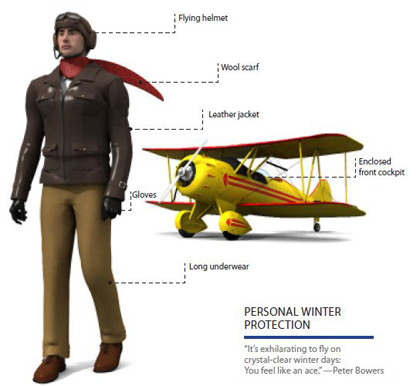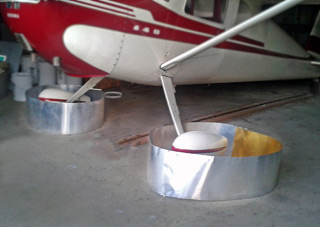Ownership: Winterize yourself
What to wear when old man winter comes to stay
 The aircraft systems that need protection from winter’s chill are well known—but how about us pilots?
The aircraft systems that need protection from winter’s chill are well known—but how about us pilots?
What steps should we take to expand our enjoyment of drafty or open-cockpit airplanes well beyond the warm-weather months? Is electronic gear such as that worn by motorcyclists or snowmobilers the answer? Or should we harken back to flying’s golden age with leather jackets and fur caps?
Peter Bowers, president of Waco Classic, a company that manufactures open-cockpit biplanes in Battle Creek, Michigan, says he and his pilots perform test and delivery flights when surface air temperatures are in the twenties.
Bowers uses an old-school approach with a few modern twists.
“I don’t think anyone’s ever come up with a better answer for flying in cold weather than long underwear and leather jackets,” Bowers said. “Long underwear is an absolute must, and leather provides more wind protection than any other material that I’ve found. A good flying jacket should allow you to seal the wrists tightly because that’s an area you can lose lots of warmth.”
Bowers also recommends flying helmets from Campbell Aero Classics (www.campbellaeroclassics.com), a New Zealand firm that exports products around the world.
“A scarf is also extremely helpful in the cold, but it can’t be a silk scarf,” he said. “It’s got to be wool.”
In open-cockpit biplanes, just like convertible cars, most of the wind comes from rear, so a good neck seal is vital.
Many of the biplanes Waco Classic sells have modern touchscreen avionics, and that can be a problem for pilots wearing gloves. Garmin GTN 650s and 750s, for example, work well with lambskin pilot gloves but not thicker ski gloves. (The same is true for the portable aera GPS line.) Ubiquitous iPads are even more sensitive to touch and temperatures below freezing. Some pilots use hunting, fishing, or photography gloves with fold-down fingers for touchscreens or other avionics that require dexterity.
Another trick Bowers uses in winter is enclosing the front passenger cockpit and removing the front windshield. Doing so dramatically reduces turbulent air in back and ensures that the heater (which uses warm air from the engine compartment) works in the rear pilot cockpit.
“Buttoning up the front cockpit makes a huge difference,” he said. “I don’t like bringing anyone along when temperatures get into the 30s or lower.”
Some snowmobile suits and motorcycle jackets and vests have plug-in adapters that can provide a great deal of heat. But many of them require more than the small amount of amperage cockpit adapters generally provide. Also, if the adapter or aircraft electrical systems fail during flight, relying on electronic warmers could be problematic.
Winter fliers should bring along the proper clothing and survival gear necessary for spending at least one night outside in case of a forced landing in a remote area.
Fur-lined bomber jackets are popular among World War II reenactors, but Bowers said some are too bulky to wear in the cockpit because they severely limit physical movement.
“Those bomber jackets look great on the ground,” he said. “But in the air they constrain a pilot’s range of motion in a way that I find unacceptable.”
Carlo Cilliers, an AirCam pilot, said flying the open-air craft in winter requires taking precautions, especially for the person riding in the rear seat, which has a great deal more exposure to wind than the front seat.
“The front seat can be pretty comfortable in the 40s,” he said. “But the back seat is much, much colder. My rule is that I use passive heat in the 40s by just dressing warmly. Anything in the 30s requires electric heat. Below that, it’s just too cold for me to enjoy the experience, no matter what I wear.”
Cilliers recommends a face mask and goggles to protect the eyes from cold, swirling winds. Chemical hand and foot warmers also help.
Fellow AirCam owner and pilot Claudius Klimt has flown his twin-engine aircraft over some of the continent’s highest elevations and flies in all seasons. His advice is to dress in layers and bundle up “as warmly as you can possibly stand it” on the ground just prior to takeoff.
“If you’re uncomfortably hot on the ground,” Klimt said, “you’ll be just about right when you get in the air.”
A fully enclosed helmet with a face mask allows Klimt to remain comfortable in bitter cold. There’s an outdoors truism that says, “If your feet are cold, put a hat on,” and experienced cold-weather pilots say there’s wisdom in that. Most heat loss comes from the head, so a warm hat and/or scarf or neck gaiter is key.
“Protecting your extremities is essential,” said Bowers. “Wool socks, a good pair of gloves, and a proper helmet aren’t luxuries. They’re necessary for safe and enjoyable winter flying.”
The payoff, Bowers said, comes on those rare crystal-clear winter days when the air is still and density altitudes are subterranean. Such conditions allow aircraft engines to produce more power and airfoils such as wings and propeller blades to provide more lift.
“It’s exhilarating to fly on days like that,” Bowers said. “You feel like an ace.”
Email [email protected].
Wall off those mice
Build a barrier to save maintenance bucks
 Tired of taking mice, or evidence of mice, for an airplane ride? Pilots all over the country now use homemade mice barriers described to us recently by Steve Oxman. AOPA Pilot editors have seen this solution in use on rural Montana ranches or anywhere there is a mice problem— which is everywhere.
Tired of taking mice, or evidence of mice, for an airplane ride? Pilots all over the country now use homemade mice barriers described to us recently by Steve Oxman. AOPA Pilot editors have seen this solution in use on rural Montana ranches or anywhere there is a mice problem— which is everywhere.
The solution is to build circular metal barriers from common flashing found on roofs or gables of homes, and clip it together with binder clips found at office supply stores. Oxman suggests 14-inch-high flashing, and 10-inch-high flashing if your aircraft has a tailwheel. He used strips 10 feet long for the mains, and a four-foot section to circle the tailwheel. He bent the metal two inches from the ends so the strip would interlock, and placed binder clips at the top and bottom of the locking area. Flashing usually has sharp edges, so wear gloves.
“Ensure that the guards are absolutely flat on the ground. Any crack between the floor and the guard is called a mouse entrance,” Oxman warns.
—Alton K. Marsh



